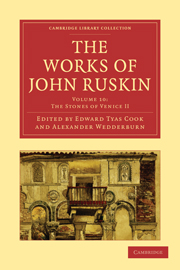INTRODUCTION TO THIS VOLUME
Published online by Cambridge University Press: 05 November 2011
Summary
Denmark Hill, 1st May 1851, morning.—All London is astir, and some part of all the world. I am sitting in my quiet room, hearing the birds sing, and about to enter on the true beginning of the second part of my Venetian work. May God help me to finish it—to His glory, and man's good.
J. Ruskin.This entry from Ruskin's diary shows the spirit in which he set himself to complete The Stones of Venice. But for the moment he made little way with it; he found, moreover, that there were still gaps in his local notes, and that another visit to Venice would be necessary. The first volume was published in March 1851; the second not till the end of July 1853, and the third at the beginning of October in the same year. The main part of the work for the two later volumes was done at Venice in the winter of 1851—1852, and in this Introduction, therefore, it will be convenient to take them together. In the Introduction to the next volume, particulars will be found of the folio work, Examples of Venetian Architecture, which was prepared in further illustration of The Stones, and is now printed at the end of the book.
The earlier part of 1851 had been, as we have described, a busy time with him. He had sent the first volume of The Stones of Venice to press; he had written and published his Notes on the Construction of Sheepfolds; he had embarked on his advocacy of the Pre-Raphaelites, and had written a pamphlet on their behalf.
- Type
- Chapter
- Information
- The Works of John Ruskin , pp. xxiii - lxviPublisher: Cambridge University PressPrint publication year: 2010First published in: 1904



